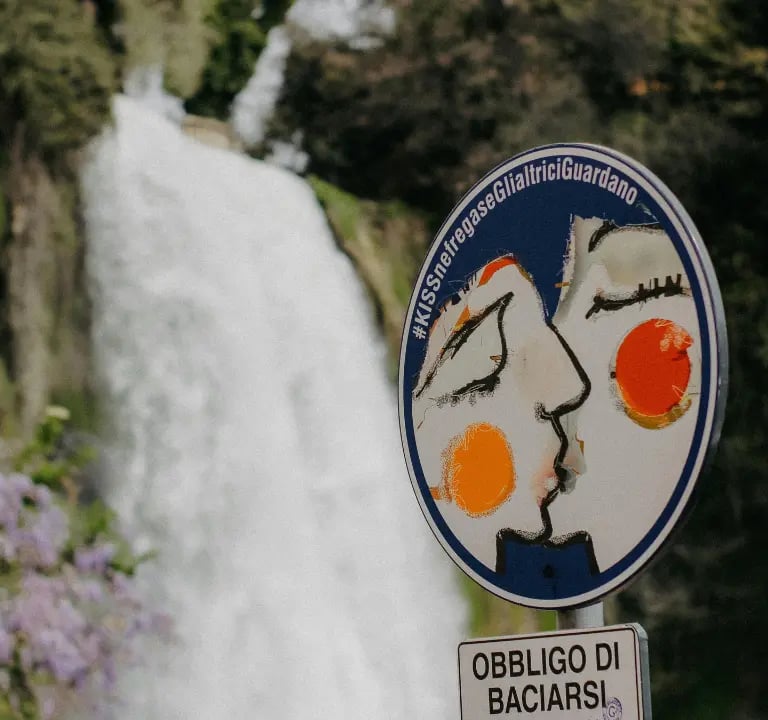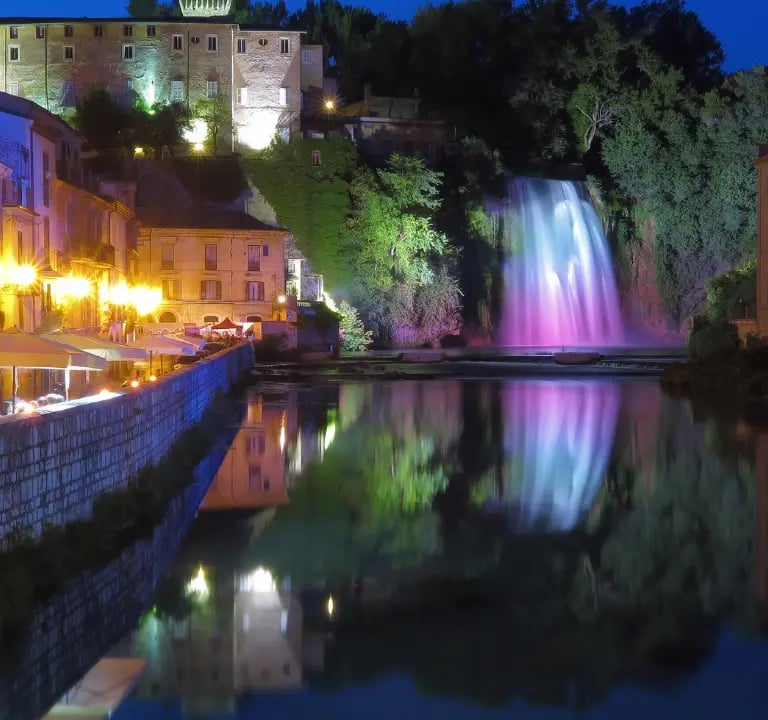Where a River Falls Through a Town: Discover Isola del Liri’s Magic!
In central Italy lies Isola del Liri, the only Italian town with a natural waterfall cascading right through its heart. Explore this hidden gem, its medieval charm, and the romantic tradition that says couples must kiss beneath the roar of the Liri River.
LAZIO
If Italy were a necklace of cities strung along rivers, Isola del Liri would be the unexpected jewel glinting at the center of Lazio. Here, the Liri River splits in two, wrapping itself around the town before reuniting in a spectacular fall — the Cascata Grande, a 27-meter waterfall that plunges between centuries-old palaces and stone bridges.
Standing in front of it for the first time, you almost question what you’re seeing: a waterfall inside a town? Yes. The only one in Italy. The water roars so close that cafés and balconies tremble slightly with its rhythm. On sunny days, fine droplets rise like silver dust over the rooftops.
Isola del Liri is one of those hidden gems in Italy that still feels authentic — no tourist crowds, no artificial gloss. Just a real Italian town where people live, work, and love beside a river that never sleeps.
A river town with industrial soul
During the 18th and 19th centuries, the energy of the Liri turned this quiet spot into a small powerhouse of paper and textile production. Its mills supplied the Kingdom of Naples and beyond. Many of those old industrial buildings have been converted into ateliers, art studios, or even boutique stays, giving the place an intriguing blend of history and rebirth.
Even today, when you walk through Via Cascata Grande, the old millstones embedded in walls whisper about the town’s working past — an echo of how the river once powered livelihoods, not just scenery.
(Reference: https://www.lazioturismo.it/en/destinazioni/isola-del-liri)
The Liri River — A Living Thread in Italian History
Long before Isola del Liri became famous for its waterfall, the river itself carried stories. The Liri River springs from the Monti Simbruini, a high, forested mountain range that forms part of the Apennines. From there it winds through valleys and ancient villages, gathering tributaries and legends alike.
The name and the myth
Its name likely comes from “Liris,” mentioned in Roman texts — a river sacred to local deities. The historian Livy wrote about battles fought along its banks; poets described its “lazy silver waters” as symbols of peace after war.
By the Middle Ages, monasteries and small castles dotted the Liri’s route. When the river reached what is now Isola del Liri, it divided naturally, forming a small island that made the perfect defensive position for early settlers. That’s how the town’s name was born: Isola del Liri — the Island of the Liri.
A rhythm of calm and power
What makes the Liri special is its dual nature: slow and calm for miles, then suddenly wild. It mirrors the temperament of the people who live here — patient and warm, but capable of fierce pride and creativity.
When you stand near the base of the Cascata Grande, you can feel this duality: a deep, steady rumble under your feet and a delicate rainbow forming in the spray above. No wonder so many artists and musicians have come here for inspiration.
For hydrology and geography enthusiasts, the river’s flow data and source regions are well documented by ISPRA (Istituto Superiore per la Protezione e la Ricerca Ambientale): https://www.isprambiente.gov.it
Castle, Cafés, and Local Charm
The Boncompagni-Viscogliosi Castle is the crown jewel of Isola del Liri. Perched dramatically right above the waterfall, it has been a silent witness to centuries of change — from medieval feuds to Bourbon politics. Built on the ruins of an older fort, the castle became home to the Boncompagni and later Viscogliosi families, who turned it into a noble residence.
Inside the castle walls
Step through the gates and you’ll find yourself surrounded by manicured gardens overlooking the falls. Inside, frescoed halls, grand staircases, and antique furnishings recall the days when the local nobility hosted concerts and soirées for travelers passing between Rome and Naples.
Today, part of the castle is open to visitors during special events, while other sections are still privately owned. The view from its terrace is unmatched — rooftops, river mist, and the green hills of Ciociaria stretching into the distance.
Daily life in the waterfall town
Wander down into Piazza Boncompagni, the beating heart of local life. In the early morning, the smell of freshly baked cornetti wafts from cafés, and the first sunlight turns the spray from the falls into gold dust. Later, families and students fill the benches, while the elderly watch the world pass by with unhurried ease.
Order a glass of Cesanese del Piglio (a ruby-red local wine) or a small aperitivo plate of local olives and cured meats, and let the town’s rhythm slow you down. This is the Italy that’s still lived, not staged.
More information on cultural visits and heritage sites: https://borghipiubelliditalia.it/borgo/isola-del-liri
Not Everyone Knows
There’s a story the locals love to tell — half legend, half playful truth — about the “obbligo di baciarsi al Liri,” the “obligation to kiss at the Liri.”
According to tradition, couples who share a kiss near the waterfall will have everlasting love. The story goes back to the 19th century, when young lovers from nearby villages would meet secretly on the bridge that overlooks the cascade. The roar of the water covered their whispered words and their stolen moments.
Over time, it became a local rite. Parents would tease engaged couples: “Have you kissed under the Liri yet? Otherwise, your love isn’t sealed!”
Even today, during summer evenings, you’ll see pairs leaning against the railing of Ponte Napoli, framed by mist and light. Some say the droplets from the falls bless whoever they touch. Others joke that if you don’t kiss here, the river itself will sulk.
It’s these small customs — unrecorded, unscripted — that make Isola del Liri one of the most beautiful cities of Italy for those who love discovering the emotional side of travel.
Festivals and Flowing Traditions
For a town of fewer than 12,000 people, Isola del Liri throws one of the liveliest music festivals in central Italy: the Liri Blues Festival.
The rhythm of summer
Every July, stages are set up along the riverbanks and in the main piazza. The roar of the waterfall becomes the festival’s natural bass line as artists from Italy, Europe, and the U.S. perform into the night. It’s not uncommon to see people dancing barefoot near the water or sitting on the old bridge, wine glass in hand, as the blues mingles with the murmur of the river.
Founded in 1988, the festival started as a grassroots event and has since hosted legends like Johnny Winter and Popa Chubby. It’s a magical fusion of small-town authenticity and big-stage talent — a perfect reflection of Isola del Liri’s spirit.
(Official festival site: https://www.liriblues.it)
Other annual highlights
The Festa di San Lorenzo in August lights up the town with fireworks, traditional music, and open-air food stalls serving arrosticini, grilled sausage, and porchetta sandwiches. In autumn, the Sagra della Ciambella celebrates a local sweet bread flavored with aniseed and wine — a humble but beloved taste of Ciociarian tradition.
Each event reminds you that Isola del Liri isn’t frozen in time. It’s a living, breathing place that continues to reinvent its connection with water, music, and joy.
Practical Magic – How to Visit
Getting There
Isola del Liri sits about halfway between Rome and Naples. By car, take the A1 motorway and exit at Ceprano (coming from the north) or Ferentino (from the south). From there, scenic provincial roads lead through olive groves and stone villages until you hear the first sound of the river.
If you’re traveling by train, take the line to Sora, then continue by local bus or taxi for the short 4 km journey to Isola del Liri.
Best Time to Visit
The best months are April to June and September to early October, when the weather is mild and the town is lively but uncrowded. The waterfall is at its most powerful in spring, while the summer evenings bring concerts and open-air life.
Where to Stay
Several family-run B&Bs and boutique hotels overlook the river. La Cascata Suite and Il Ninfeo del Liri are popular for their panoramic balconies and direct views of the falls. For an exclusive touch, inquire about the limited suites inside the Boncompagni Castle complex — waking up to the sound of rushing water is pure poetry.
What to Eat
The town belongs to the Ciociaria area, famous for rustic, honest cuisine. Try:
Pasta alla ciociara — a rich mix of sausage, tomato, and pecorino.
Fagioli con le cotiche — beans stewed with pork rind.
Ciambelline al vino — small ring-shaped cookies soaked in local wine.
A dinner along Via Cascata Grande offers a unique sensory show: candlelight flickers on stone walls while mist from the falls cools the air.
Beyond Isola del Liri – Exploring Ciociaria
If you have more time, use Isola del Liri as your base to explore Ciociaria, a region of rolling hills, medieval villages, and quiet abbeys that remains off beaten path Italy.
Drive 20 minutes to Arpino, birthplace of Cicero, where ancient stone arches open to spectacular valley views. Visit Abbazia di Casamari, one of Italy’s best-preserved Cistercian monasteries, where monks still produce herbal liqueurs. Or head to Sora, a nearby market town that offers a more urban energy while retaining its river charm.
Each of these places, like Isola del Liri itself, shares a balance of history, hospitality, and that elusive sense of timeless Italy.
For travel routes and regional planning, see https://www.visitlazio.com
FAQ
Q1: What makes Isola del Liri unique in Italy?
It’s the only Italian town with a natural waterfall in its center, where daily life unfolds to the soundtrack of rushing water.
Q2: Can I visit the waterfall up close?
Yes — you can approach the falls from multiple viewing points, including bridges, café terraces, and a riverside promenade. During low flow, you can even get close enough to feel the spray.
Q3: Is there a legend about kissing near the waterfall?
Absolutely. Local lore says couples must kiss by the Liri to bless their love — a romantic ritual that’s become part of the town’s identity.
Q4: What’s the best way to experience the Liri Blues Festival?
Arrive early evening, grab a riverside seat, and let the blues blend with the roar of the cascade. It’s a once-in-a-lifetime concert setting.
Q5: Is it suitable for families?
Yes, it’s safe, walkable, and welcoming. Kids love watching the waterfall from the bridges, and locals are famously warm to visitors.


